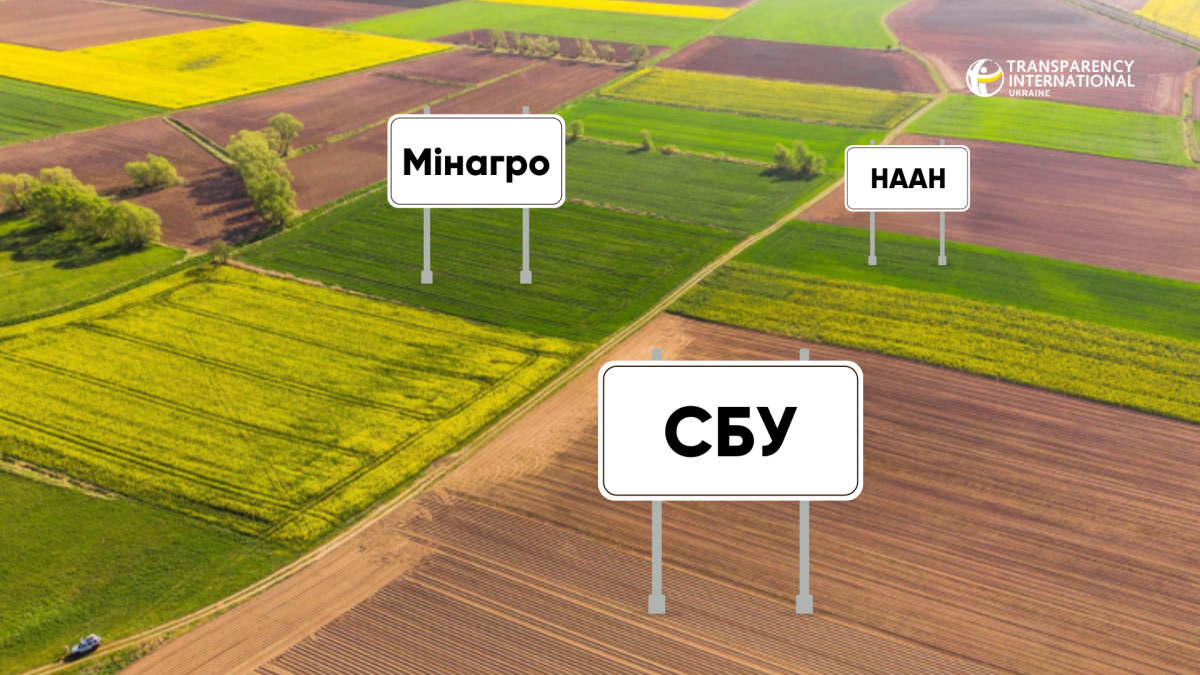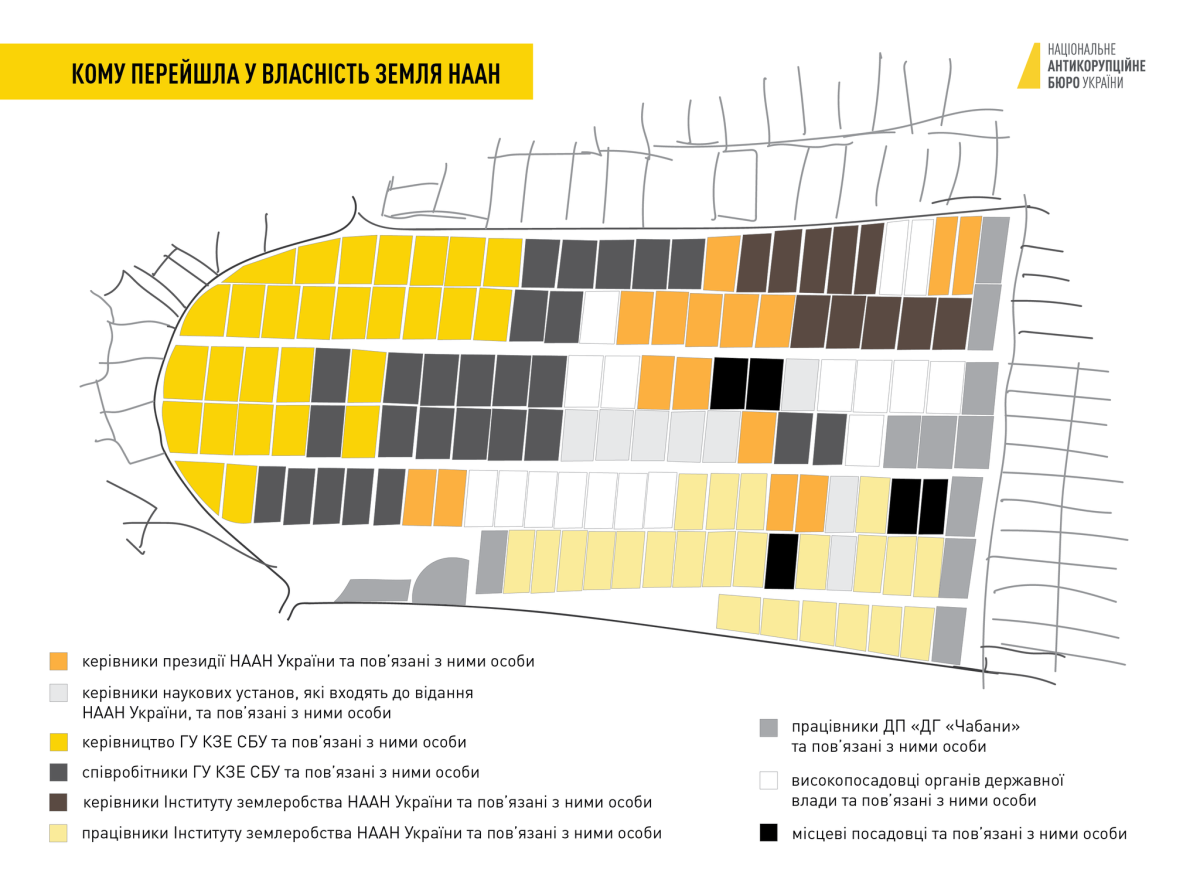

Almost 140 especially valuable land plots near Kyiv were illegally privatized by a number of officials of the National Academy of Agrarian Sciences of Ukraine (NAAS), the Security Service of Ukraine, and the Ministry of Agrarian Policy. This is what the NABU-SAPO claims as part of the investigation into the events that occurred more than 10 years ago. However, we paid attention to this case not even because of the scheme’s scale, but for another reason.
Interestingly, even before the start of the trial, five senior officials of the NAAS were removed from the list of defendants in the case. It was they, according to the initial version of the investigation, who made illegal decisions and made this crime possible.
Read on to find out why this happened and how.
Interestingly, even before the start of the trial, five senior officials of the NAAS were removed from the list of defendants in the case. It was they, according to the initial version of the investigation, who made illegal decisions and made this crime possible.
Oksana Kopiichuk
How did the scheme function?
During the investigation, NABU detectives found out that NAAS officials, outside their powers, terminated the right of permanent use by the research farm Chabany (an organization within the structure of the NAAS) of 144 land plots in Hatne, near Kyiv. Of these, 138 land plots had already been transferred to private ownership and another 6 at the time of the launch of the investigation were in the process of re-registration. This scheme entails more than 15 hectares of “especially valuable” land intended for research. These lands eventually became the private property of members of the Presidium of the NAAS, their close relatives, employees of the SSU, the Ministry of Agrarian Policy, and other persons.
The plots in the case were part of 330 hectares of land, which in 2003 were transferred to the permanent use of the research farm Chabany within the Institute of Agriculture of the NAAS. The head of the Kyiv-Sviatoshyn District State Administration made such a transfer by his order with the appropriate intended purpose.
What is important is that, in accordance with the then provisions of the Land Code of Ukraine, the right to permanent use could only be terminated with the consent of the Verkhovna Rada. The same applies to the change in intended purpose. However, the NAAS, according to the investigation, managed to make such a decision without the consent of the parliament. The formal reason for that was that in September 2013, employees of the Chabany RF requested the allocation of such land plots for gardening.
As part of the criminal plan, the NAAS received a letter from the head of the SSU, but without his signature, allegedly, about the need to terminate the right of permanent use of these land plots by the research farm Chabany in order to transfer these lands to the Security Service. Then there was a second letter with similar content, but it was signed by the Deputy Head of the SSU. However, there is no significant difference between the two letters; in any case, such appeals were contrary to the law because only the Cabinet of Ministers can initiate such decisions.
The now-accused director of the research farm then did not object to the allocation of land plots to employees. The other accused, the director of the Institute of Agriculture of the NAAS, did not object to that either.
Subsequently, the SSU letter, along with other materials, was submitted to the presidium of the NAAS for consideration, but they “forgot” to add a certificate of the special value of these lands. As a result of the voting, the NAAS adopted a corresponding resolution in which it agreed to withdraw 15.12 hectares of land from the use of the Chabany RF. Subsequently, the director of the research farm sent a letter on the termination of the right of permanent use to the State Land Agency in the Kyiv region. On its basis, the State Land Agency allocated land plots by separate orders to pre-approved people, including relatives of the Academy Presidium employees, who made decisions on the withdrawal of this land.
In total, 138 people turned out to be new “owners” of these lands, and all of them can be divided into four large groups:
- officials of the NAAS, the Institute of Agriculture and related persons. For example, Yaroslav Gadzalo, still current president of the NAAS; his daughter and her husband; Oleksandr Ishchuk, then director of the SE RF Chabany; his wife; the grandmother of his son’s wife; the in-law of Viktor Kaminskyi, director of the Institute of Agriculture; Anatolii Zaryshniak, vice-president of the NAAS, and his wife—judge of the Kyiv Court of Appeal, as well as their daughter;
- Main Department of Counterintelligence Protection of the State’s Interests in the Sphere of Economic Security of the Security Service of Ukraine. For example, the leadership of this department, their relatives and, overall, persons who were not related to either the Academy or the SSU, but, having received land plots, issued powers of attorney for their disposal to close relatives of the then leadership of this department of the Security Service;
- high-ranking officials, in particular persons associated with the then Deputy Minister of Agrarian Policy and Food, with the Secretariat of the Cabinet of Ministers of Ukraine, etc.;
- local officials, including officials of the Chabany village council; persons associated with the prosecutor of the Kyiv-Sviatoshynskyi district; persons associated with Yurii Bondar, head of the Kyiv-Sviatoshynskyi district state administration; their relatives, etc.
The NABU estimated that the officials caused more than UAH 42 million in damage to the state through their actions.
The plots in the case were part of 330 hectares of land, which in 2003 were transferred to the permanent use of the research farm Chabany within the Institute of Agriculture of the NAAS. The head of the Kyiv-Sviatoshyn District State Administration made such a transfer by his order with the appropriate intended purpose.
Oksana Kopiichuk
Removal of NAAS top management from the list of defendants in the case
In January 2020, five senior officials of the Academy were served with a suspicion notice. Namely:
- Yaroslav Hadzalo, president of the National Academy of Sciences of Ukraine (vice president at the time of the crime);
- Ihor Hrynyk, director of the Institute of Horticulture of the NAAS (the first vice-president of the NAAS at the time of the crime);
- Ihor Ibatullin, first vice-rector of the National University of Life and Environmental Sciences of Ukraine (vice-president of the NAAS at the time of the crime).
- Anatolii Zaryshniak, vice president, chief academic secretary of the NAAS (academician-secretary of the NAAS branch at the time of the crime);
- Viacheslav Vlasov, director of the National Scientific Center V.Ye. Tairov Institute of Viticulture and Winemaking.
According to the investigation, these 5 people, as members of the NAAS presidium, voted for the allocation of land plots from among the especially valuable ones, and then re-registered them to their names and to their close relatives. However, in May 2020, the head of the SAPO closed the proceedings against the top NAAS officials because there was a lack of evidence to prove the mercenary motives of the defendants during the voting.
In April 2021, Prosecutor General Iryna Venediktova revoked this resolution of the head of the SAPO because, in her opinion, the SAPO did not do everything possible to verify the involvement of the NAAS leadership in this scheme. In May 2022, the SAPO prosecutor closed the proceedings against the top officials of the NAAS again.
Were these people artificially removed from the case? The CPC does oblige to close the proceedings if there is insufficient evidence to prove guilt and there is no opportunity to obtain it.
When the NABU served new suspicions, the Bureau was sure that the NAAS management had re-registered the land plots to their names and to their close relatives. But then, for unknown reasons, the investigation abandoned the idea that the senior officials of the NAAS had acted for mercenary motives. However, the opinion of law enforcement officers did not change regarding the rest of the defendants, who had previously been charged with the same actions. The HACC has been hearing this case for a long time.
The list of current defendants includes:
- Roman Kucher—former head of the State Land Cadastre Department of the Main Directorate of the State Land Agency in the Kyiv region;
- Stanislav Hubin—ex-deputy head of the Main Directorate of the State Land Agency in the Kyiv region;
- Ivan Shevchenko—ex-head of the department of the NSC Institute of Agriculture of the NAAS;
- Oleksandr Ishchuk—ex-director of SE RF Chabany;
- Viktor Kaminskyi—director of the NSC Institute of Agriculture of the NAAS;
- Anush Balian—vice president of the NAAS;
- Svitlana Kovtun—former chief scientific secretary of the NAAS;
- Vitalii Oborskyi—SSU officer;
- Vasyl Petrychenko—ex-president of the NAAS.
All these people are charged with misappropriation, embezzlement or conversion of property by malversation, and in addition—an unfinished attempt at such actions. The court may sentence the defendants to imprisonment for up to 15 years, with confiscation of property. But the question arises: what is the difference between the actions of these individuals and the five top officials of the Academy?
When the NABU served new suspicions, the Bureau was sure that the NAAS management had re-registered the land plots to their names and to their close relatives. But then, for unknown reasons, the investigation abandoned the idea that the senior officials of the NAAS had acted for mercenary motives.
Oksana Kopiichuk
When is the finale?
In December 2019, the SAPO sent the indictment to the court. Since then, the Anti-Corruption Court has been holding court hearings to consider this case; currently, the defense is taking part in court debates.
In the future, the accused will be able to use the last word. Given that there are many of them, the process will take some time. At the same time, all the evidence has already been studied, so most of the processual procedures are over.
The land in Hatne is now seized; the arrest was imposed in November 2017 by the Solomianskyi District Court of Kyiv. In April 2018, the Kyiv Court of Appeal upheld this decision. If the guilt of the defendants is recognized by the court, land plots as a subject of the crime may be recovered within special forfeiture.
We at Transparency International Ukraine will continue monitoring this case because the verdict in it is looming on the horizon, and there are still many questions left. And most importantly—will all the perpetrators of this land scheme really be punished? After all, these are the answers that should underlie truly high-quality justice.
The land in Hatne is now seized; the arrest was imposed in November 2017 by the Solomianskyi District Court of Kyiv. In April 2018, the Kyiv Court of Appeal upheld this decision. If the guilt of the defendants is recognized by the court, land plots as a subject of the crime may be recovered within special forfeiture.
Oksana Kopiichuk







